A GG Selfie
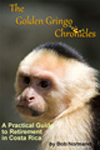 |
Publisher's Corner
If you would like to read a version of
the Golden Gringo Chronicles
in a narrative format,
as a hard-copy novel
or an e-book
check it out HERE
JUST RELEASED! Mariposa, A Love Story of Costa Rica JUST RELEASED!
NOW AVAILABLE ON AMAZON.COM!
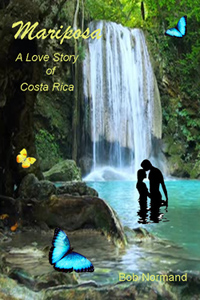 Five hundred years before the Spanish found the American
continent, around the end of the first millennium, Native Americans lived and prospered in Central America, including the land now known as Costa Rica. Truly a natural wonderland then and now, the natives were able to employ their farming skills and prosper from the rich soils, the forests filled with game, herbs, and spices, and the lakes and two oceans rich with fish and crustaceans.
Five hundred years before the Spanish found the American
continent, around the end of the first millennium, Native Americans lived and prospered in Central America, including the land now known as Costa Rica. Truly a natural wonderland then and now, the natives were able to employ their farming skills and prosper from the rich soils, the forests filled with game, herbs, and spices, and the lakes and two oceans rich with fish and crustaceans.
Mariposa, or butterfly, is a story about two young Native Americans, each a favored child of a chief, but of different tribes. These two tribes, historically hostile to each other, lived a few days march apart in the mountains north and east of Costa Rica’s central valley.
The two natives meet by accident, fall in love and begin to plan a life together only to be frustrated by events beyond their control. The lovers are eventually drawn to a mountain volcano which is thought by many to be the home of the gods, particularly Sib'ö, the Great Spirit, who they believe had created the world.
The story as written incorporates the classic ending of Costa Rica's Legend of Zurqui, one that reflects the beauty, mystery and spirituality that is Costa Rica.
Preview the Book on Amazon.com at: Mariposa Preview
(This is Chapter 1 in its entirety)
ORDER IT HERE ($7.95): Mariposa on Amazon.com (Kindle Version Available - $4.99)
See All the Books by this Author Here: Books by Bob Normand
Broken News
(All the News That's Fit to Reprint)
Tourism Up
Main Terminal at
Juan Santamaria Airport
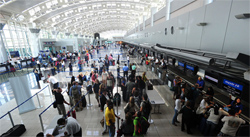 |
The Instituto Costarricense de Turismo (ICT) and the Minister of Tourism recently announced that Costa rica set a new record in tourism in the first quarter of this year. Some $1.2 billion was "left behind" by foreign visitors during that period (most of it was purposefully left behind exercising their tourist duty, I presume). Putting that number in perspective, it exceeds the amount spent here during each of the entire years of 2000 and 2001.
It looks like the trend will continue. In 2015, five more airlines initiated flights to Costa Rica: Southwest Airlines, Volaris (a budget Mexican airline), Alaska Airlines, Thomson and British Airways. Also, our second international airport in Liberia was expanded in recent years and there continues to be talk about building a third international airport, probably along the southern Pacific coast (pray that it's not Quepos, it's still quiet here).
Bienvenidos amigos and amigos-to-be.
Sneaky Snake
A Talamancan Palm-Pitviper
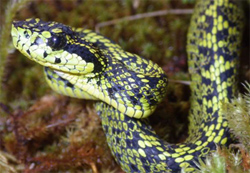 |
As if we needed another example of Costa Rica's incredible biodiversity, a new species of pit viper has been discovered. (Why couldn't it have been a butterfly?) This makes the 140th specie of snake-like reptile here. Over 20 of them are poisonous.
The name of this slithery critter is the Talamancan Palm-Pitviper and its picture is shown to the right (ain't it purty)? Evidently this snake is similar in markings to an existing pitviper (the Black-Speckled Palm-Pitviper) but DNA results now confirm that it is indeed a separate specie. Adding to the fact that they have coloration in common with other snakes is the fact that they live at high altitudes in the mountains of Talamanca and in relatively small populations, so they were not easy to detect.
This is one sneaky snake. All the more reason to take along a knowledgeable guide when you're walking around the countryside here.
Shrinking Work Week (Maybe)
The Chronicles has sometimes referred to the large disparity between per capita income in the U.S. and in Costa Rica; it's currently more than four times ($57,350 versus $13,570) but that ratio has declined significantly in the last 20 years. On top of this, the standard work week here is six eight hour days or 48 hours per week (36 hours for night work). What one day of the week is free to the employee is something agreed to between employee and employer but there are premiums for Sunday and night work.
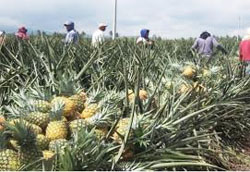 |
The Workforce is a Changing |
 |
Now a bill has been introduced into the National Legislature (Assemblea) to change the work week to five days but at 10 hours per day , not really shortening the work week but condensing it and leaving Saturdays and Sundays free to many. My guess is that under this system, Fridays will get shorter than the others by at least 2 hours. My guess also is that, with the weekends now totally free and with the road improvements over the last five years, our beach areas will get much busier on the weekends.
Yet the nature of the work force in Costa Rica is changing rapidly also. Skills needed for software development, call centers and other technical jobs is producing more office prone environments that better fit the new work week should it happen (it's not passed by the Assemblea yet). While agriculture exports are still very important and will continue to be so, Costa Rica is becoming a haven for tech companies because of its location, good telecom infrastructure and a good supply of technically trained labor from the schools and universities.
The country is growing up.
Dam Big Business
One of the things Costa Rica is blessed with is water. We get plenty of rain annually. In the months of September, October and November we average a combined rainfall of 60 (that's sixty) inches of rain versus, let's say, 26 inches in Florida in their heaviest three months (July-September) and Boston with 11 in their heaviest three months (Jan-Mar). (See Singing in the Rain for these stats) Most of the rain finds it's way to the Pacific or Caribbean seas via large rivers.
Location of New Reventazón Dam
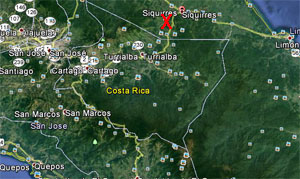 |
That kind of rainfall makes powerful rivers and hydroelectric power generation an attractive source of electricity. Costa Rica has taken it to heart because of the "renewable" nature of this form of energy production. There are some 70+ dam projects in the country producing electricity, both small amounts for specific purposes and large outputs for general populace and business consumption. During much of the year now all electric production is produced using "renewable" sources; hydropower being over 80% and the rest coming from geothermal energy, biomass, solar power, and wind.
Reventazón Dam Now Complete
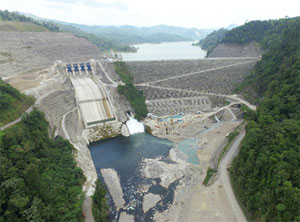 |
In September of this year, Costa Rica inaugurated it's most ambitious hydropower plant yet on the Reventazón River near Siquirres (red X on map above). This $1.4 billion project, in a country with a $1.6 billion annual federal budget and only a $50B GDP is the largest hydropower plant ever built in Central America. It is expected to produce 525,000 megawatts of electricity (I don't know about you amigos but when people start quoting wattage in these things, even as an engineer it doesn't mean much to me, let alone a mega amount of them). That amount of fritz is supposed to power up to 1/3 of the homes in the country (that I can relate to). A photo of the finished dam is to the right.
But nothing comes without consequences. Power costs here are not cheap; I just paid my monthly bill at a rate of 19.5 cents per kwh (in a country that has an average income per capita less than one third that of the U.S.). The current typical rate in Florida is about 8.5 according to internet reports. The trick here seems to be to use power sparingly which, because of their situation, Ticos are wont to do.
ROMEO Co-Founder Repatriates
The R.O.M.E.O. Club was founded in Quepos in December 2009, almost seven years ago. The acronym stands for Retired Old Men Eating Out.
ROMEO Brian M.
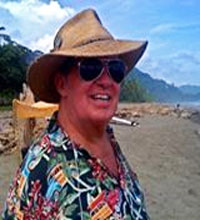 |
The original founders of the ROMEO Club were Paul P., Brian M., and Bob N. (GG), three retired U.S. expat dudes that thought it would be a good idea to sample a different restaurant at least once per month. It's been running now for almost seven years and we've covered virtually every restaurant in Quepos/Manuel Antonio as well as other places in Costa Rica and a few neighboring countries. Eating in all these places was tough work but we were dedicated and did our best.
Unfortunately, our good friend Paul P. passed away in February of 2012. Now our second co-founder, Brian M. (who is credited for expropriating our group's acronym from the U.S. organization of the same name) has decided, reluctantly, to move back to Tampa from whence he came, where he's expecting to undergo some medical procedures which he feels are best done in his home town.
In the early days the three original ROMEOS were also charged with the responsibility of supervising all activities at Manuel Antonio beach, an additional heavy duty, particularly as it regarded the treatment of our food and drink vendors (ceviche, empanadas, brochettes, fruit, coconut water etc.). We gave it our all.
I will miss my fellow ROMEO and hope that he can find his way back here at least for periodic visits and to occasionally assume the position of ROMEO Emeritus.
Good luck Brian!
TOP
Rumble Talk
(Shaky Happenings and Weather Observations On or About the Pacific Rim)
Early Shaker
 The month started off with a thud. On September 3 about four o'clock in the afternoon, GG was sitting at the computer fumbling with emails and facebook messages when there was a noticeable and increasing vibration that could only be interpreted as a developing terremoto. After about two or three seconds there was a hard, noticeable thud that shook the building.
The month started off with a thud. On September 3 about four o'clock in the afternoon, GG was sitting at the computer fumbling with emails and facebook messages when there was a noticeable and increasing vibration that could only be interpreted as a developing terremoto. After about two or three seconds there was a hard, noticeable thud that shook the building.
At that point GG quickly poised himself like the runner statue to the left as I was preparing to dive for a safe area. That area that I have so designated is a narrow space between my bed and a built-in armoire which I have nominated for just such an occasion based on suggestions that experts on building collapses make (see "triangle of life"). Having lived through a 7.6 shaker in September, 2012, I've become a boy scout on this issue - be prepared.
The latest quake registered only 4.7 on the Richter scale but had an epicenter at a relatively shallow depth of 14 km. It was also quite close to Quepos. According to the U.S. Geological Survey the epicenter was about 13 km NW of San Isidro or about 20 km SE of Quepos. Its proximity and shallowness to us account for the strongly felt thud.
Turrialba Active Again
Turrialba in Sept 2016
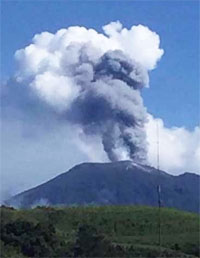 |
Let's go back for a moment to the third quarter of 2012 and the tremor that occurred on September 5, 2012 in particular. That was the second most powerful earthquake in Costa Rican history (7.6R, only 0.1R less than the all time record in Limón in 1991 that killed 47 and compared to the smaller 6.4 in Cartago in 1910 that killed over 700). But no fatalities were recorded in the 2012 quake, with an epicenter in the Nicoya near Samara, the low incidence of fatality (0) and injury being attribute to improvements in construction standards and practices in the last 100 years.
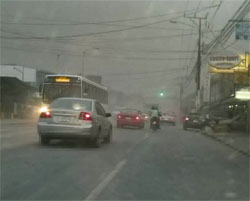 Just after the 2012 biggie in the Nicoya, scientists warned that, despite the large slippage, only 50% of the potential energy that could have been released was actually released. Since that time several of our volcanoes have been active with Turrialba leading the pack. Turri (I feel like I know her personally now) has been active in 2012, 2014, 2015 and much of 2016, periodically dusting the central valley where about 50% of the population lives. The ash fall out can block out the sun as shown in the photo to the right taken in Guadalupe, an eastern barrio of San José not too far from the city center.
Just after the 2012 biggie in the Nicoya, scientists warned that, despite the large slippage, only 50% of the potential energy that could have been released was actually released. Since that time several of our volcanoes have been active with Turrialba leading the pack. Turri (I feel like I know her personally now) has been active in 2012, 2014, 2015 and much of 2016, periodically dusting the central valley where about 50% of the population lives. The ash fall out can block out the sun as shown in the photo to the right taken in Guadalupe, an eastern barrio of San José not too far from the city center.
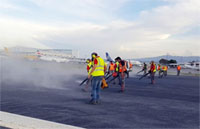 The periodic ash fallout has sometimes closed the major international airport (SJO - Juan Santamaria) as volcanic ash and jet engines are not very compatible. SJO and the secondary airport at Pavas were closed again on September 19 and not reopened until nearly a day later, inconveniencing some 3,000 travelers. It took a major effort by the airport staff to blow away and clean up the runways so that normal travel could resume (photo left).
The periodic ash fallout has sometimes closed the major international airport (SJO - Juan Santamaria) as volcanic ash and jet engines are not very compatible. SJO and the secondary airport at Pavas were closed again on September 19 and not reopened until nearly a day later, inconveniencing some 3,000 travelers. It took a major effort by the airport staff to blow away and clean up the runways so that normal travel could resume (photo left).
Update Sept 26. Ooops, Turri blew her stack again around 9 PM on Sunday night September 25 and five red-eye flights at SJO were cancelled between 2 to 5 AM. The airport was back in business by 5 AM on Monday, the crews having swept away another pile of ash.
Stay tuned, this stuff is not an event, it's a long term process.
Good Weather Report
InterNations is an international organization (Website here: InterNations) devoted to gathering and disbursing information about expats and their experiences living in countries other that their homeland. They do an annual survey of thousands of their members and end up ranking countries by their popularity among expats in a number of categories. One of them is weather.
Manuel Antonio Beach
Jan-May, All Day
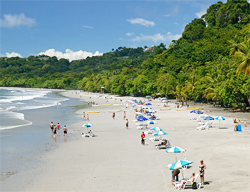 |
Over 14,000 respondents to their questionnaire gave up their preferences concerning a number of areas of interest (see the article below: "Costa Rica as an Expat Destination" for more information). InterNations published the results for the top 67 countries from their 2016 survey and Costa Rica ranked pretty high overall (#6 of 67) and also came in first for the best weather. While GG is not surprised at the weather ranking I would suggest that it's even better than a simple ranking can describe because, in fact, someone living here can choose from several distinct weather options, all within one small country.
Manuel Antonio Beach, Jun-Dec Most Mornings
 |
You can live in a populated area with availability of all the amenities that suggests; an area which is warm much of the day followed by cool, breezy nights that minimize the need for air conditioning (Central Valley).
Or you can choose the hotter, more humid, often jungle-like areas with all their wildness in the central and south Pacific Coast as well as part of the Caribbean coasts.
Or you can live on the side of a mountain with incredible views and cool breezes (anywhere along the central mountain spine).
Or, if you're a beachophile like me, you can live very near a beach with warm water (78-84F) all year long. In some cases you can combine the last two within a short driving distance (again, on the Pacific Coast). And the beaches, oh my, the beaches; there is no end to them with hundreds of miles of Caribbean and Pacific coast line at your beckon.
"But amigo, you have a lot of rain." says the non-resident and potential expat. Correct, oh perceptive mist meister, and we often have 2-3 times the annual rainfall of many areas in the states. But much of our rain in the rainy season (May 15 - Dec 15) comes in late afternoon, evening or night (I'm writing this at 9:30 pm and there's rumbling outside) and most often the mornings are dry and sunny, i.e., still beachable. Yes, the two pictures of Manuel Antonio above are the same amigo, that's my point.
So yes, GG can easily second the InterNations motion, Costa Rica is at the top of the list when it comes to weather, at least for we older folks. You fanatical skiers and lugers beware, stick with the Rockies, you'll find no snow or ice here.
Check Out Recent Earthquakes Around the World
Posted by the U.S. Geodetic Survey: Today's Quakes |
TOP
Search the Golden Gringo Chronicles Archives for Topics That Interest You
You can use our Archives to explore almost 200 feature articles of the Golden Gringo Chronicles plus find Broken News items and ROMEO restaurant reviews. Enter your topic or item to search in the Google Search Routine below and follow the links offered from the search results. Suggestion: Enter only a simple, precise and unique as possible keyword or two in order to narrow the number of references retrieved:
Golden Gringo Chronicles - Enter Search Here
Readers: Send comments, suggestions, ideas, jocular observations and meaningless
statements concerning the Chronicles to GG here: gg@goldengringo.com
¿Que Es Eso? Department
(What is This?)
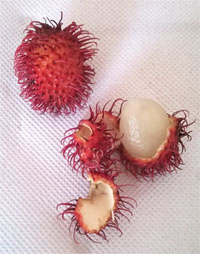
It's a hairy bug.
It's a mutant pineapple.
What am I?
Answer in What's-in-a-Word Section Below
(If you have lived in Costa Rica a while,
you'll know what this is)
The Legend of El Cadejos
(When Drinking Goes to the Dogs)
The Chronicles has made note of various legends of Costa Rica over the eight years we have been publishing and GG even wrote a book based on one of them ("Mariposa", see Publisher's Corner above). For a full listing of Costa Rica legends previously covered in the Chronicles, some twelve articles, go HERE.
The Legend of El Cadejos is a familiar one to many Costa Ricans but it's also a legend that is widely known in other parts of Central America. As a result, there are several versions that vary in specific details. The origin and purpose of the legend is unclear but two things are consistent from version to version; vicious dogs and excessive drinking.
El Cadejos
 |
El Cadejos is the name of the dog (in some versions there are two dogs - more on this later). Here's the Costa Rica version of the story (excerpted and adapted from the Go Visit Costa Rica Blog):
Joaquin
& Friend
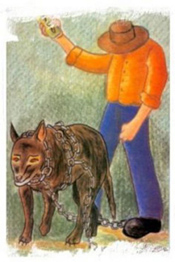 |
"The legend begins with a young man from the city of Cartago named Joaquin. Joaquin was what you might call a party animal...except Joaquin liked to go overboard and drink way too much. His hard partying lifestyle began to affect those around him, especially his parents.
Over the years, Joaquin's lifestyle would be the cause of much frustration for his father, who often begged his son to settle down and straighten his life out. For months he begged and pleaded with the wild boy to lead a saner life, but Joaquin continued to party day in and day out. Eventually, the man stopped being so nice to his son, leading to loud arguments with the boy about his lifestyle - all of which seemed to fall on deaf ears.
One day Joaquin went out on the bender to end all benders, hitting every bar in the city, visiting several sketchy places and having a wild time doing so. For seven days, the boy drank and partied to excess, paying no heed to the protests of his father and living with reckless abandon. When Joaquin eventually returned to his family home, his father was beyond furious.
As his son attempted to explain where he had been, the man simply stared at his son. His rage changed his eyes to a crimson color, and as he began to speak to his son, the boy's eyes took on a similar shade. The man launched into an irate tirade at the boy, yelling and cursing at him for hours. Over time, the curses began to change the boy, turning him into a large black dog known as cadejos. The beast now wanders across the country, following partiers who have had a bit too much to drink and scaring them back onto the right path."
A Kopstoot
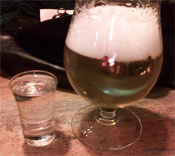 |
My oh my, talk about going to the dogs! Some interpreters of the legend suggest a moralistic bent on the story by saying if you drink way too much, you will meet up with El Cadejos in the night. Not GG, of course...
 Well, actually, there was that night in Amsterdam in the '70's when I thought I saw El Cadejos running along the Prinsengracht Canal. Guess I had had too many kopstoots that night (see What's-in-a-Word below for the English meaning of that gem). A kopstoot is a small glass of Dutch gin (Yonge Genever) straight up chased with a Pils (beer). Too many kopstoots will likely produce El Cadejos (or something else just as scary).
Well, actually, there was that night in Amsterdam in the '70's when I thought I saw El Cadejos running along the Prinsengracht Canal. Guess I had had too many kopstoots that night (see What's-in-a-Word below for the English meaning of that gem). A kopstoot is a small glass of Dutch gin (Yonge Genever) straight up chased with a Pils (beer). Too many kopstoots will likely produce El Cadejos (or something else just as scary).
 In other central american countries (Nicaragua, Honduras, El Salvador) the legend favors more than one dog. In these versions there usually is one white and one black dog. As might be expected, the white dog symbolizes good while the black dog represents evil. The black dog haunts the night dwellers and drinkers while the white dog is expected to defend the righteous. When the two dogs meet they are expected to fight, but never to win, just like the never ending struggle between good and evil. In Guatemala they add a third gray dog to the story who is responsible for protecting lost and sick children.
In other central american countries (Nicaragua, Honduras, El Salvador) the legend favors more than one dog. In these versions there usually is one white and one black dog. As might be expected, the white dog symbolizes good while the black dog represents evil. The black dog haunts the night dwellers and drinkers while the white dog is expected to defend the righteous. When the two dogs meet they are expected to fight, but never to win, just like the never ending struggle between good and evil. In Guatemala they add a third gray dog to the story who is responsible for protecting lost and sick children.
There was a long tradition among native americans that humans possessed a corresponding dog spirit ("nahuales") and dogs appear on pottery and tombstones as well as actually being buried with their owners. In pictures and representations of cadejos, the dog is usually pictured with chains, which may be the reason for the name of the dog as cadenas is the Spanish word for chains.
¡Solo Bueno!
TOP
Costa Rica as an Expat Destination
(#1 for Best Weather Says This Survey)
There are a number of organizations that take the trouble to rate and rank countries in terms of their friendliness and support for their expat residents. They range from travel guides to more comprehensive and detailed analyses like that done by International Living magazine. That latter source was analyzed in a report in the March 2013 Chronicle and can be found here: Rating Retirement.
 GG mentioned in the Rumble Talk section above that InterNations is another international organization that does an annual ranking of, and for, expats around the world. Their full report for 2016, including the analysis protocol as well as ranking by category and country can be found here: 2016 InterNations Expat Rankings Report (takes a couple of minutes to load).
GG mentioned in the Rumble Talk section above that InterNations is another international organization that does an annual ranking of, and for, expats around the world. Their full report for 2016, including the analysis protocol as well as ranking by category and country can be found here: 2016 InterNations Expat Rankings Report (takes a couple of minutes to load).
The report, according to InterNations, represents the results of the following: "A total of 14,272 expatriates took part, representing 174 nationalities and living in 191 different countries or overseas territories." Expats were asked to consider five broad areas of concern to expats: Quality of Life, Ease of Settling In, Personal Finance, Working Abroad and Family Life. Within each category are a number of sub-categories and within the sub-categories are a number of questions.
As an example, the survey measures one category called Quality of Life. In this section participants are asked how they rate the extent of their leisure options, how happy they feel personally where they're living, how satisfied they were with the ability to travel and transport stuff, how good do they think there health and well-being in living there and finally, how safe and secure they feel.
Only the top 67 countries, representing about one third of all the countries surveyed, were reported. Within that selection, each category and sub-category were ranked from 1-67. The following is a summary of the categories and sub-categories that were reported. The numbers in parentheses refer to the position of Costa Rica in the report - those in red mean the ranking is in the top five of all surveyed:
 |
San José |
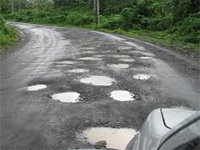 |
A Secondary Road
(They're Not All This Bad) |
Quality of Life (5) - Leisure Options (3), Personal Happiness (1), Travel & Transport (35), Health & Well Being (9), Safety and Security (18).
Yes we have our share of getting around problems (see photos left) but with regard to leisure options we have it all except snow and ice sports (GG doesn't expect to see a luge run here in the near future unless it's installed in a five story building with a lot of air conditioning). The wildness of this place promotes interest in health and incredible fruits and vegetables cement one's interest in healthy eating. By north american standards our crime rates are higher but in relation to central america, they're among the lowest in most categories.
Ease of Settling In (2) - Feeling Welcome (4), Friendliness (3), Finding Friends (3), Language (12).
What can I say; friendly, friendly, friendly. ¡Todas los costaricenses son mis amigos! (All Costa Ricans are my friends!). As for language, It's not important how poorly you pronounce a word as it is important for you to just keep trying until you get it.
Personal Finance (43). Cost of Living (48)
Personal finance is a feeling of being happy with your personal financial situation while living overseas; perhaps it's about having extra to spend. With regard to cost of living. Taiwan, Ukraine and Ecuador are the top three in this category; i.e., the lowest cost of living. Some people move to Costa Rica believing it is much cheaper that the U.S. Maybe this was true 30 years ago and maybe it is is still true for California and New York but in general it's not that way anymore. A single person, however, can still live comfortably on basic necessities for $2,000 per month.
Working Abroad (Job & Career (28), Work-Life Balance (10), Job Security(N/A).
 One of the interesting ratings related to Work-Life Balance came in the relationship area. Expats were asked if they were happy in their relationships while living abroad. Costa Rica came in second with only Malta beating them out as number one.
One of the interesting ratings related to Work-Life Balance came in the relationship area. Expats were asked if they were happy in their relationships while living abroad. Costa Rica came in second with only Malta beating them out as number one.
Having come here for retirement, GG can't personally offer any gems of wisdom on work-life balance - it's all balanced toward the life side for me. One observation I might make is that few job-seekers move here, top executives for start-ups being an exception, because the disparity in salaries greatly favors the developed countries. Look at it this way, the per capita income in Costa Rica is about $15,400 while in the U.S. it's about $55,800.
Family Life (22) Availability/Costs of Childcare & Education (20), Quality of Education(25), Family Well-Being (13)
The Scandinavian countries (Norway, Sweden, Finland, Denmark) seem to dominate in the family life category.
 It's interesting to note that the only area where Costa Rica was below the median (i.e., it came in #34) was in the Personal Finance and cost of living category. Otherwise it is in the top half and comes in among the top five of sixty-seven countries for Leisure Options, Personal Happiness, Feeling Welcome, Friendliness, and Finding Friends. Not a bad record and not a bad environment in which to live.
It's interesting to note that the only area where Costa Rica was below the median (i.e., it came in #34) was in the Personal Finance and cost of living category. Otherwise it is in the top half and comes in among the top five of sixty-seven countries for Leisure Options, Personal Happiness, Feeling Welcome, Friendliness, and Finding Friends. Not a bad record and not a bad environment in which to live.
As GG pointed out in the 2013 article about the International Living survey, Rating Retirement, one could and should customize these analyses to fit your particular situation as well as your personal likes and dislikes. To do that in the aforementioned International Living survey GG added a personal weighting factor to each of the categories (the engineering bent in me is hard to repress).
Taking an average of the ratings given in each category didn't seem logical to GG. I mean, why would I average the rating in real estate with the rating in healthcare to come up with an overall country rating when the former has little importance to me as a retired renter but the latter has significant importance to me as a retired old fart. And cost of living for me was close behind healthcare in personal importance. So I ended up giving healthcare, an importance factor of 5 followed by Cost of Living at 4 and Real Estate at 0. That brought Costa Rica closer to the top for me, confirming my choice of where I wanted to be as an expat (or maybe it just confirmed my ability to manipulate numbers and rating systems).
Yet, we must start with a good base and the InterNations 2016 Expat Insider report helps you do just that. And, in addition, it offers a good deal of additional comments and judgments to help you make your assessments better as well. Probably the most common misconception of what it's like to move to Costa Rica is the belief that it's just like moving to another state in the U.S. and that U.S. practices and experience will be the same here. It's not that it's better or worse but it definitely is different.
I suggest you look up the report using the link above if you're planning an expat move. Know thyself and thy adopted country better Señor and Señora expat and you'll be a lot likelier to be less surprised and happier when you finally get where you decide to go.
¡Solo Bueno!
TOP
Costa Rica Independence Day
(Showing Off the Red, White and Blue)
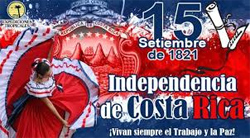 September 15 is Costa Rica independence day but you don't have to remember that, it's obvious from all the activity that goes on, much of it for the entire month of September. This year was the 195th anniversary of Costa Rica's separation (and that of all Latin America for that matter) from Spain in 1821. Happy Birthday Costa Rica!
September 15 is Costa Rica independence day but you don't have to remember that, it's obvious from all the activity that goes on, much of it for the entire month of September. This year was the 195th anniversary of Costa Rica's separation (and that of all Latin America for that matter) from Spain in 1821. Happy Birthday Costa Rica!
The National Flag
 |
The flags come out early in the month and will stay out for the remainder of the month as will mucho red, white and blue bunting. Costa Ricans are proud of their heritage, their country and have a passion for celebrations and festivals of any kind. What else can I say?
Torch of Freedom
Bearer
 |
The official part of the celebration starts several days earlier in the countries north of us where a relay of runners, made up of high school kids, brings a torch down that started in Guatemala. This symbolizes the route used to bring down the original announcement of independence (the news actually didn't reach Costa Rica until October 3, 1821 because of a lack of communications and difficulty crossing the mountains). This year the torch reached Peñas Blancas, the border crossing with Nicaragua on Tuesday morning the 13th. It would take two more days to pass through Costa Rica, stopping in San José for the national torch ceremony.
Don Alfredo
 |
The torch ceremony is a relatively new event having been started in 1964 at the behest of a Costa Rican school teacher who convinced the several governments involved to start this commemoration. But now virtually every city, town and hamlet has it's own torch ceremony thanks to teacher Alfredo Cruz Bolaños, a well-known and loved personage who is now a historical figure himself, having studied physical education in the U.S. and who returned to Costa Rica to start the National Institute of Physical Education. It's estimated that Don Alfredo taught in excess of 80,000 students how to swim during his lifetime. He died in 2006 at the age of 87.
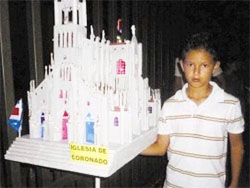 The torch tradition gave rise to another. Children are encouraged to build small houses that are used as lanterns on the night before Dia de Independencia. They're called faroles (Spanish for lanterns) and can be quite elaborate as shown in the photo to the left. This young man obviously spent a great deal of time (or mom and dad did) constructing his farol, modeling it after one of the famous churches of Costa Rica (note the wooden post at the bottom to carry the lighted farol in a parade).
The torch tradition gave rise to another. Children are encouraged to build small houses that are used as lanterns on the night before Dia de Independencia. They're called faroles (Spanish for lanterns) and can be quite elaborate as shown in the photo to the left. This young man obviously spent a great deal of time (or mom and dad did) constructing his farol, modeling it after one of the famous churches of Costa Rica (note the wooden post at the bottom to carry the lighted farol in a parade).
Another practice of children here occurs at precisely 6 PM on the night before independence day when all the children in the country stop what they are doing, stand up and sing the national anthem, the first verse of which is given below):

I might have translated it a little differently, but the right sentiment is there.
This is where I bring up one of GG's prejudices (only one at this time). I can easily agree that all kids in the world are cute but I can't get away from believing that Costa Rican kids are the cutest on the globe. Here are a few examples taken from Independence Day activities:
The kids make Independence Day lots of fun to watch.
For more on the history of Costa Rica go here:
History of Costa Rica: Pre-Columbian
History of Costa Rica: Spanish Occupation
History of Costa Rica: The Modern Era
and selected history: Various Historical Articles
¡Solo Bueno!
TOP
Health Stuff
Note: The information given in this section is offered as news information only and does not indicate GGC confirmation or denial of the accuracy of the treatment or a recommendation to pursue it, nor can we or do we guarantee the efficacy of the results nor validity of the conclusions proffered.
(How's that for a disclaimer?) |
Report: Alcohol Causes Seven Types of Cancers
As if being chased by El Cadejos wasn't enough, a new report from a university in New Zealand says their research proves a "causal association with cancer of the oropharynx, larynx, esophagus, liver, colon, rectum and female breast". The study is based on analysis of ten years of data from a number of cancer research organizations around the world. They make the outright statement that " alcohol was responsible for 5.8 percent of all cancer deaths in 2012".
Actually, I'm a bit suspicious of the conclusion because that number - 5.8% - is not much different than the general per cent of alcoholics in the population (7-10%). "Correlation does not necessarily mean causation" as a statistician buddy of mine used to say.
To add insult to injury the researchers further stated that, although it's often been suggested that a glass of wine a day helps the cardiovascular system, “evidence that moderate drinking provides protection against cardiovascular disease is not strong.”
My oh my, is their nothing sacred anymore?
Coffee Grounds Remove Heavy Metals
The Chronicles have periodically reported on the health benefits of drinking coffee that keep getting reported in the press; we best summarized it here:Coffee as Health Food.
 Of course, making coffee also produces waste in the form of spent grounds. Literally millions of tons of used grounds are produced annually from restaurants, the beverage industry and people in their homes. In this age of increased awareness of waste and how to deal with it, that kind of output is a concern.
Of course, making coffee also produces waste in the form of spent grounds. Literally millions of tons of used grounds are produced annually from restaurants, the beverage industry and people in their homes. In this age of increased awareness of waste and how to deal with it, that kind of output is a concern.
Coffee grounds have been used as fertilizer for years. It produces a nitrogen-rich fertilizer but evidently the nitrogen does not get transferred to the growing plant. GG used to have a three bin composter in an earlier life which I had constructed using the plans and instructions from the Victory Garden book and television series written by James Crockett - 1977. I worked the grounds along with garden waste and kitchen scraps into the composter and, at the end of a couple of months, I had a rich fluffy compost that Crockett called the "brown-gold Cadillac". You could grow rocks in that stuff.
Now comes a report from ACS (the American Chemical Society) that spent grounds, in a powder form, can rid water of heavy metal ions, those nasty ions which can cause serious health problems. Researchers suspended powered spent coffee grounds in a bioelastomeric foam (whatever that dude is) and passed lead contaminated water over it (through it?), removing two-thirds of the lead in the water. They got an even better result with mercury, removing 90%+ of that heavy metal.
More research is needed to optimize the experiment and conjure up a commercial level process (that's where we chemical engineering dudes come in) but it sounds very promising, especially since it includes a recycling component.
Taller Ticos
When I grew up and reached adult height in the 1960's GG registered 6' 0" which was tall in comparison to previous generations (my mom had been only 5' 5' and my dad 5' 7"). I was a giant among dwarfs, or so it seemed to my mom. I'm sure a lot of it had to do with her good cooking that was interspersed with the appropriate amount of burgers, grilled meats and other "junk foods" adding to the protein intake. When peoples begin to thrive and become more and more affluent, there is a corresponding growth in height as people have access to better nutrition as well as better health care.
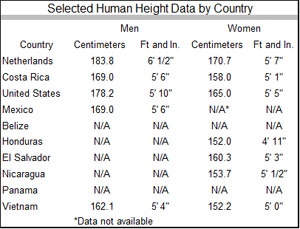 So it is with Costa Rica and a recent report noted that the average height of Costa Rican men and women has grown substantially in the last 100 years. Ticos grew 11.2 cm (4.4 inches) to reach 169 cm (5' 6") during the last century while women had a great gain and beat them out by an inch reaching today's average of 158 cm (5' 1"). The ladies still lag the men by 5" but their gaining on us, amigos.
So it is with Costa Rica and a recent report noted that the average height of Costa Rican men and women has grown substantially in the last 100 years. Ticos grew 11.2 cm (4.4 inches) to reach 169 cm (5' 6") during the last century while women had a great gain and beat them out by an inch reaching today's average of 158 cm (5' 1"). The ladies still lag the men by 5" but their gaining on us, amigos.
The tallest people in the world at the moment come from the Netherlands (see table right). The shortest heights posted are for people from Vietnam. The U.S. is near the top and Costa Rica falls right in the middle (we gringos and gringas still have four inches on both Ticos and Ticas). Costa Rican women have a few inches on all their Central American counterparts with the exception of the ladies of El Salvador.
The "Twins"
 |
But about the Dutch thing. That confirms GG's suspicions that were first developed a few years ago sitting at the Quepos bus station. A troop of young Dutchmen were waiting for the Manuel Antonio beach bus and I walked into the middle of them. I felt like Danny DeVito in "Twins" (1988 - Universal Pictures, co-starring Arnold Schwarzenegger).
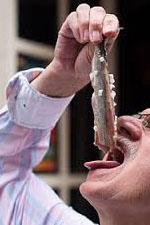 The longest Dutchman in that team turned out to be 7' 6" tall and he didn't even play basketball. Maybe it's the groene haring that's producing these giants. Groene haring or "green" herring is a large, slice of raw herring that may have been sprinkled with chopped onions (see photo right). You eat it in one gulp and wash it down with a kopstoot....er, there I go again with the kopstoots.
The longest Dutchman in that team turned out to be 7' 6" tall and he didn't even play basketball. Maybe it's the groene haring that's producing these giants. Groene haring or "green" herring is a large, slice of raw herring that may have been sprinkled with chopped onions (see photo right). You eat it in one gulp and wash it down with a kopstoot....er, there I go again with the kopstoots.
Oh, let's just assume it's the Erwtensoep (Dutch pea soup) that's making these kids so tall..
Dat groene haring is lekker mineer?
TOP
Travel Quote of the Month
"Like all great travelers, I have seen more than I remember, and remember more than I have seen." – Benjamin Disraeli |
What's-in-a-Word
Answer to Que Eso
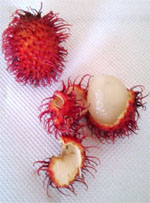 It's a fruit! Locals call them mamones (mah-moan-ees), a short version of the more formal name Mamón Chino. They are, in fact, lychee nuts (with the nut still inside the fleshy part shown in the picture to the left. Beginning in September and for a few months the season for mamones is on. I've been munching them for several weeks now (yum).
It's a fruit! Locals call them mamones (mah-moan-ees), a short version of the more formal name Mamón Chino. They are, in fact, lychee nuts (with the nut still inside the fleshy part shown in the picture to the left. Beginning in September and for a few months the season for mamones is on. I've been munching them for several weeks now (yum).
Lychee nuts are reputed to have been introduced here by the Chinese when they came to help build the Costa Rican railroad from Limon to Alejuela in the late 1800's. Hence the "Chino" in the local, two-word descriptor of the fruit. This fruit is also called Rambutan after the tree of the same name and is a native of south asia. To read more on this amazing fruit go here: Rambutan.
More interesting than the local common name is the fact that the word mamón carries several meanings in the dictionary, to wit: Mamón as an adjective: (still nursing), a. unweaned; Sara sostenía al bebé mamón en sus brazos. Sara held the unweaned baby in her arms; b. suckling, El bebé mamón tuvo que contentarse con el chupete de momento. The suckling baby had to be content with the pacifier for the moment.
That definition may come the closest to the fruit because, to eat it, one gives the rubbery-haired shell a quick twist with two hands to break away the covering and expose the fruit. The fruit is then sucked out or pulled out with the teeth. Be careful not to bite down hard on the bulbous flesh because their is a large nut at the center which can easily break a tooth. One becomes adept at scraping the flesh off the nut with the teeth. The flesh is soft, sweet and delicious.
And yes, of course, it's healthy; a 100g/3.5oz serving will provide two-thirds of your RDA of Vitamin C. It also provides a valuable source of copper, which the human body does not produce by itself and which is essential to the proper functioning of organs and metabolic processes.
Here is a more interesting twist in the meaning of mamón that is given in the dictionary: (colloquial) (conceited) (from Mexico),
a. cocky (colloquial); El sabelotodo ese es muy mamón por eso no le cae bien a nadie. That know-it-all is really cocky and that's why no one likes him. And as a masculine or feminine noun: (colloquial) (pejorative) (stupid person);
dumb ass (colloquial) (vulgar), No puedo creer que el mamón haya dicho esa estupidez en público. I can't believe the dumb ass said such a stupid thing in public.
Muchas gracias amigos, my vocabulary is much better now that I know the Spanish word for dumb ass.
Cadejo (cah-day-ho)
From cadenas, Spanish for chains. The legend says that El Cadejos always had chains around him and you would here them rattle before you would see the dog.
Kopstoot (cop-stōdte)
Dutch to English: Head-butt. The dudes I hung out with in Amsterdam in the '70's used to translate it as "a kick in the head".
TOP
ROMEO Corner
(Retired Old Men Eating Out)
El Arado, Manuel Antonio
Location: 200 meters down the Old Road to Quepos from the Mono Azul bus stop.
Hours: Breakfast, Lunch and Dinner Mon-Sun
Parking: Ample off street at the restaurant
Contact: Tel: 2777-0928; Email: anachavarria07@gmail.com; Website: N/A
Reviewing ROMEOS: Dozens of us for a party.
To Review Our Rating System and Procedure, go here: R.O.M.E.O. Rating System
This is a charming little, out of the way, restaurant located on the old road to Quepos from Manuel Antonio. It is owned and operated by a Tica named Anna C. who is almost always on the premises helping her staff put out good food. Many of we gringos and other cultural imports have known Anna for a number of years and she's become a dear friend. I personally have had countless breakfasts and a number of lunches there and always enjoyed the food. It's simple but fresh and well presented.
The restaurant is open air but normally has a good breeze passing through it and one is often diverted in attention by the squawk of a macaw or a group of them. Likewise, it's not unusual for a troop of Titi monkeys to access the roof of the restaurant having run up and down the power lines that run on the side of the street. My guess is they can smell a good meal from a great distance and I have in on authority that Anna lays out some treats for them on the roof at the rear of the restaurant. To get to those treats they have to run across the tin roof and sometimes they hang over the edge to see what we're doing, shaking their heads in amazement. For atmosphere we give El Arado four sloths, knocking off a small amount for the stereotypical hard wood chairs (GG's back problem).
Some people, and a couple of standard internet rating guides, call El Arado a soda, but it's more of a restaurant than that. It offers not only the standard rice con variousthings dishes as wells as casados that sodas offer but there also is one of the best pescado enteros (whole fried fish) in the area. Other seafood dishes are also offered.
 Occasionally we hold an event there for a major holiday, particularly a gringo holiday (e.g., Thanksgiving, Christmas, Easter) and Anna allows us to add, pot-luck style, to her core offering. Such was the case recently when we held a going away brunch for our repatriating ROMEO Brian M. mentioned in the Broken News section above.
Occasionally we hold an event there for a major holiday, particularly a gringo holiday (e.g., Thanksgiving, Christmas, Easter) and Anna allows us to add, pot-luck style, to her core offering. Such was the case recently when we held a going away brunch for our repatriating ROMEO Brian M. mentioned in the Broken News section above.
For this event, Anna provided the core lunch including arroz con pollo with vegetables, green salad and a classic Tico sweet combination of maduros y piña (ripe plantains and pineapple). Anna's food, as usual, was fresh, tasty and ample for a group of 22.
The pot luck part of the brunch produced an array of attendees' favorites including a frittata, additional salads and a couple of very sinful desserts (one of them was a rich cake with a soft icing and blueberries - zowie).
For food quality we give El Arado five sloths.
|
 |
.jpg) .5 .5 |
$$$.5 |
Value Index = 129 |
With regard to service, Anna and her people at El Arado have always been quick to make sure we are comfortable and have everything we need. Five sloths for service also. That yields an overall rating of 4.5 sloths for atmosphere, food quality and service.
Cost of a meal there is below Manuel Antonio average for similar restaurants and this may be the one area where it is equal to a soda. We give a cost factor of 3.5 dollars and that in turn yields a value index equal to: 4.5/3.5x100= 129 putting it in the top 20% of our value ratings.
The ROMEOs can easily recommend El Arado for good food in a real Costa Rican atmosphere and at a reasonable price.
TOP
Golden Gringo Chronicles Novel and E-Books Now Available!
 The story of the Golden Gringo Chronicles is also available as a hard copy novel of 192 pages available through Amazon and all major online retailers. ($9.95)
The story of the Golden Gringo Chronicles is also available as a hard copy novel of 192 pages available through Amazon and all major online retailers. ($9.95)
Amazon link: GGC, the Book. (Kindle Edition available)
Follow GG through the first six years of his odyssey in making the decision to retire in Costa Rica, overcoming the trials and tribulations of moving and obtaining residency there and the fun and experience of actually living in Ticoland.
Ride along with the Golden Gringo as he learns about the rich, varied culture of Costa Rica, the incredible bio diversity, the charming nature of the Costa Rican people and the ease with which a sometimes clueless ex-pat can assimilate into a small southwestern town on the Pacific coast.
Whether you are already a Costa Rican resident, someone contemplating a move here or just a traveler who enjoys different cultures, you will find the Golden Gringo Chronicles interesting, entertaining and informative about Costa Rica.
A narrative version of the Golden Gringo Chronicles is now also available as a trilogy of E-books in formats compatible with virtually all electronic platforms.
Part 1: (FREE!)
Leaving the Homeland
Part 2: ($3.99)
The Early Years
Part 3: ($3.99)
Becoming Tico, Maybe
Click on Part Number above for E-book sample downloads or click the price above right for purchase. (The best price is on Part 1; it's FREE)
Opt-In Here to Receive Your Free Copy Monthly
The Golden Gringo Chronicles is a free newsletter that is non-political, non-commercial and, hopefully, entertaining. By signing up you will receive an email each month around the first of the month giving you the links to the latest edition as well as to each individual feature and departmental section.
CLICK HERE TO SIGN-UP FOR THE
GOLDEN GRINGO CHRONICLES
or Email me at gg@goldengringo.com
Website: www.goldengringo.com

The Golden Gringo
Pura Vida!
To Contact GGC World Headquarters (yuk, yuk) to make comments, suggest topics or criticize my bad jokes, just send an email to: gg@goldengringo.com.
Be pithy but kind; I'm sensitive.
Unsubscribe from Golden Gringo Chronicles


 Five hundred years before the Spanish found the American
continent, around the end of the first millennium, Native Americans lived and prospered in Central America, including the land now known as Costa Rica. Truly a natural wonderland then and now, the natives were able to employ their farming skills and prosper from the rich soils, the forests filled with game, herbs, and spices, and the lakes and two oceans rich with fish and crustaceans.
Five hundred years before the Spanish found the American
continent, around the end of the first millennium, Native Americans lived and prospered in Central America, including the land now known as Costa Rica. Truly a natural wonderland then and now, the natives were able to employ their farming skills and prosper from the rich soils, the forests filled with game, herbs, and spices, and the lakes and two oceans rich with fish and crustaceans.






 The month started off with a thud. On September 3 about four o'clock in the afternoon, GG was sitting at the computer fumbling with emails and facebook messages when there was a noticeable and increasing vibration that could only be interpreted as a developing terremoto. After about two or three seconds there was a hard, noticeable thud that shook the building.
The month started off with a thud. On September 3 about four o'clock in the afternoon, GG was sitting at the computer fumbling with emails and facebook messages when there was a noticeable and increasing vibration that could only be interpreted as a developing terremoto. After about two or three seconds there was a hard, noticeable thud that shook the building.
 Just after the 2012 biggie in the Nicoya, scientists warned that, despite the large slippage, only 50% of the potential energy that could have been released was actually released. Since that time several of our volcanoes have been active with Turrialba leading the pack. Turri (I feel like I know her personally now) has been active in 2012, 2014, 2015 and much of 2016, periodically dusting the central valley where about 50% of the population lives. The ash fall out can block out the sun as shown in the photo to the right taken in Guadalupe, an eastern barrio of San José not too far from the city center.
Just after the 2012 biggie in the Nicoya, scientists warned that, despite the large slippage, only 50% of the potential energy that could have been released was actually released. Since that time several of our volcanoes have been active with Turrialba leading the pack. Turri (I feel like I know her personally now) has been active in 2012, 2014, 2015 and much of 2016, periodically dusting the central valley where about 50% of the population lives. The ash fall out can block out the sun as shown in the photo to the right taken in Guadalupe, an eastern barrio of San José not too far from the city center. The periodic ash fallout has sometimes closed the major international airport (SJO - Juan Santamaria) as volcanic ash and jet engines are not very compatible. SJO and the secondary airport at Pavas were closed again on September 19 and not reopened until nearly a day later, inconveniencing some 3,000 travelers. It took a major effort by the airport staff to blow away and clean up the runways so that normal travel could resume (photo left).
The periodic ash fallout has sometimes closed the major international airport (SJO - Juan Santamaria) as volcanic ash and jet engines are not very compatible. SJO and the secondary airport at Pavas were closed again on September 19 and not reopened until nearly a day later, inconveniencing some 3,000 travelers. It took a major effort by the airport staff to blow away and clean up the runways so that normal travel could resume (photo left).





 In other central american countries (Nicaragua, Honduras, El Salvador) the legend favors more than one dog. In these versions there usually is one white and one black dog. As might be expected, the white dog symbolizes good while the black dog represents evil. The black dog haunts the night dwellers and drinkers while the white dog is expected to defend the righteous. When the two dogs meet they are expected to fight, but never to win, just like the never ending struggle between good and evil. In Guatemala they add a third gray dog to the story who is responsible for protecting lost and sick children.
In other central american countries (Nicaragua, Honduras, El Salvador) the legend favors more than one dog. In these versions there usually is one white and one black dog. As might be expected, the white dog symbolizes good while the black dog represents evil. The black dog haunts the night dwellers and drinkers while the white dog is expected to defend the righteous. When the two dogs meet they are expected to fight, but never to win, just like the never ending struggle between good and evil. In Guatemala they add a third gray dog to the story who is responsible for protecting lost and sick children. GG mentioned in the Rumble Talk section above that
GG mentioned in the Rumble Talk section above that 

 One of the interesting ratings related to Work-Life Balance came in the relationship area. Expats were asked if they were happy in their relationships while living abroad. Costa Rica came in second with only Malta beating them out as number one.
One of the interesting ratings related to Work-Life Balance came in the relationship area. Expats were asked if they were happy in their relationships while living abroad. Costa Rica came in second with only Malta beating them out as number one. It's interesting to note that the only area where Costa Rica was below the median (i.e., it came in #34) was in the Personal Finance and cost of living category. Otherwise it is in the top half and comes in among the top five of sixty-seven countries for Leisure Options, Personal Happiness, Feeling Welcome, Friendliness, and Finding Friends. Not a bad record and not a bad environment in which to live.
It's interesting to note that the only area where Costa Rica was below the median (i.e., it came in #34) was in the Personal Finance and cost of living category. Otherwise it is in the top half and comes in among the top five of sixty-seven countries for Leisure Options, Personal Happiness, Feeling Welcome, Friendliness, and Finding Friends. Not a bad record and not a bad environment in which to live. September 15 is Costa Rica independence day but you don't have to remember that, it's obvious from all the activity that goes on, much of it for the entire month of September. This year was the 195th anniversary of Costa Rica's separation (and that of all Latin America for that matter) from Spain in 1821. Happy Birthday Costa Rica!
September 15 is Costa Rica independence day but you don't have to remember that, it's obvious from all the activity that goes on, much of it for the entire month of September. This year was the 195th anniversary of Costa Rica's separation (and that of all Latin America for that matter) from Spain in 1821. Happy Birthday Costa Rica!


 The torch tradition gave rise to another. Children are encouraged to build small houses that are used as lanterns on the night before Dia de Independencia. They're called faroles (Spanish for lanterns) and can be quite elaborate as shown in the photo to the left. This young man obviously spent a great deal of time (or mom and dad did) constructing his farol, modeling it after one of the famous churches of Costa Rica (note the wooden post at the bottom to carry the lighted farol in a parade).
The torch tradition gave rise to another. Children are encouraged to build small houses that are used as lanterns on the night before Dia de Independencia. They're called faroles (Spanish for lanterns) and can be quite elaborate as shown in the photo to the left. This young man obviously spent a great deal of time (or mom and dad did) constructing his farol, modeling it after one of the famous churches of Costa Rica (note the wooden post at the bottom to carry the lighted farol in a parade). 
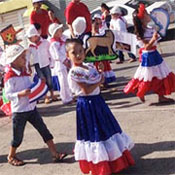
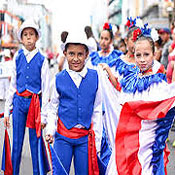
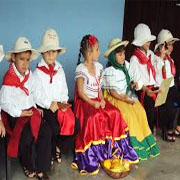
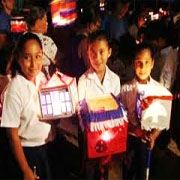
 Of course, making coffee also produces waste in the form of spent grounds. Literally millions of tons of used grounds are produced annually from restaurants, the beverage industry and people in their homes. In this age of increased awareness of waste and how to deal with it, that kind of output is a concern.
Of course, making coffee also produces waste in the form of spent grounds. Literally millions of tons of used grounds are produced annually from restaurants, the beverage industry and people in their homes. In this age of increased awareness of waste and how to deal with it, that kind of output is a concern. So it is with Costa Rica and a recent report noted that the average height of Costa Rican men and women has grown substantially in the last 100 years. Ticos grew 11.2 cm (4.4 inches) to reach 169 cm (5' 6") during the last century while women had a great gain and beat them out by an inch reaching today's average of 158 cm (5' 1"). The ladies still lag the men by 5" but their gaining on us, amigos.
So it is with Costa Rica and a recent report noted that the average height of Costa Rican men and women has grown substantially in the last 100 years. Ticos grew 11.2 cm (4.4 inches) to reach 169 cm (5' 6") during the last century while women had a great gain and beat them out by an inch reaching today's average of 158 cm (5' 1"). The ladies still lag the men by 5" but their gaining on us, amigos.
 The longest Dutchman in that team turned out to be 7' 6" tall and he didn't even play basketball. Maybe it's the groene haring that's producing these giants. Groene haring or "green" herring is a large, slice of raw herring that may have been sprinkled with chopped onions (see photo right). You eat it in one gulp and wash it down with a kopstoot....er, there I go again with the kopstoots.
The longest Dutchman in that team turned out to be 7' 6" tall and he didn't even play basketball. Maybe it's the groene haring that's producing these giants. Groene haring or "green" herring is a large, slice of raw herring that may have been sprinkled with chopped onions (see photo right). You eat it in one gulp and wash it down with a kopstoot....er, there I go again with the kopstoots.
 Occasionally we hold an event there for a major holiday, particularly a gringo holiday (e.g., Thanksgiving, Christmas, Easter) and Anna allows us to add, pot-luck style, to her core offering. Such was the case recently when we held a going away brunch for our repatriating ROMEO Brian M. mentioned in the Broken News section
Occasionally we hold an event there for a major holiday, particularly a gringo holiday (e.g., Thanksgiving, Christmas, Easter) and Anna allows us to add, pot-luck style, to her core offering. Such was the case recently when we held a going away brunch for our repatriating ROMEO Brian M. mentioned in the Broken News section 




